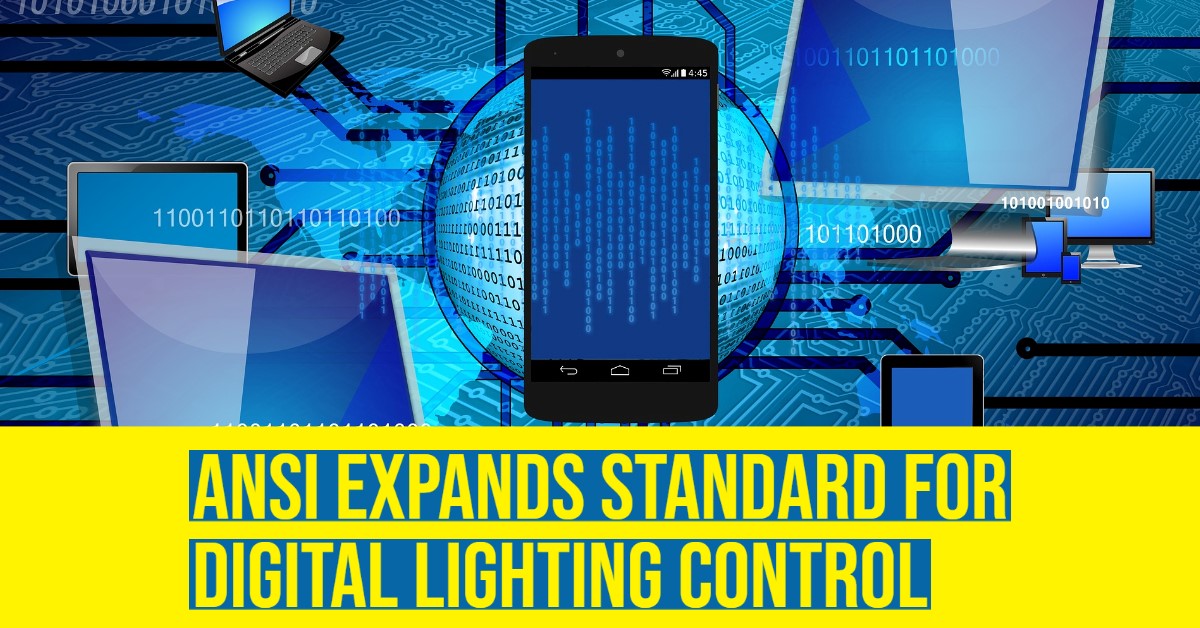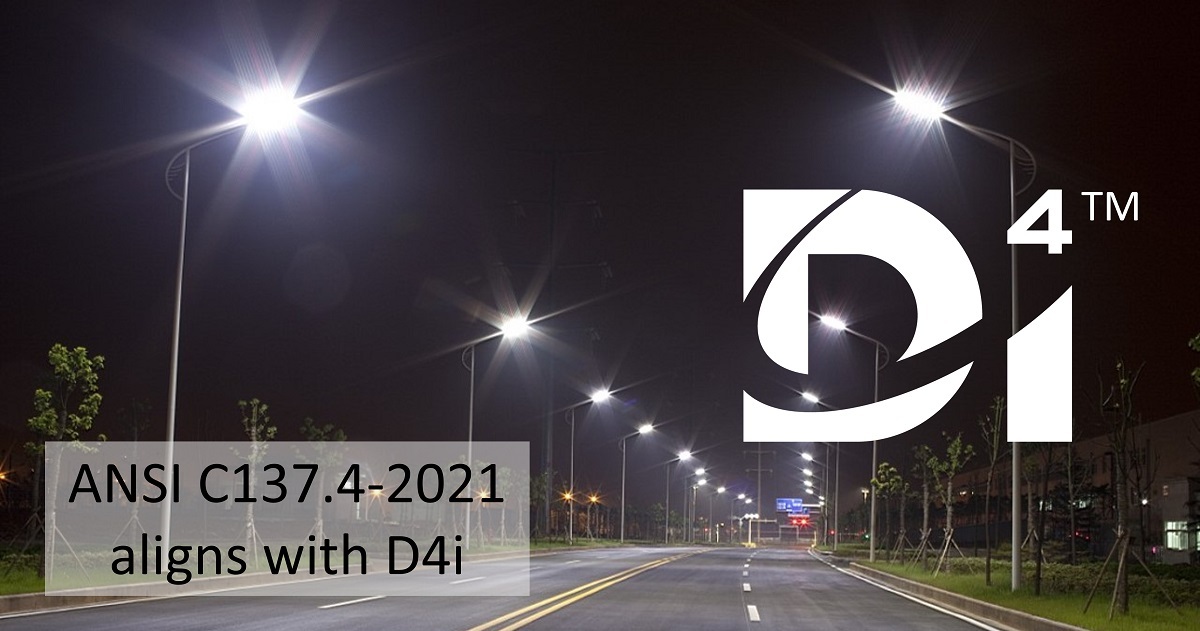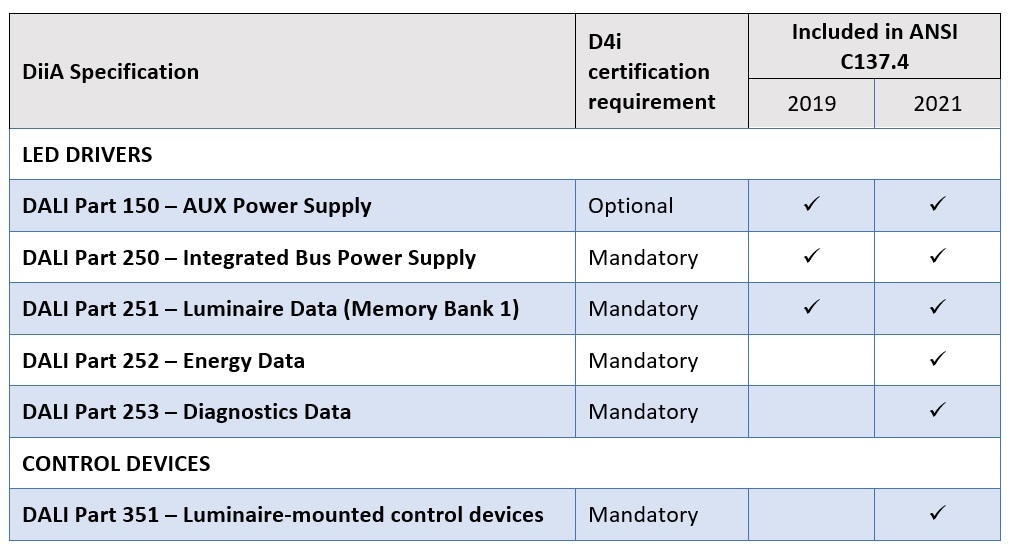April 14, 2022
ANSI Expands Standard for Digital Lighting Control

Data reporting, diagnostics, sensors and NLCs added to standards
Piscataway, NJ, USA -- Harmonization of international standards related to DALI lighting control continues with the publication of the updated ANSI C137.4-2021 standard in North America. ANSI C137.4-2021 builds on the international standard IEC 62386 (which underpins the DALI communication protocol) and has additional characteristics and features that align very closely with the D4i family of specifications from the DALI Alliance, a global lighting-industry organization.
“We welcome the further alignment of ANSI C137.4-2021 and D4i, which is expected to lead to more availability of D4i certified and interoperable drivers, sensors, controllers and smart luminaires,” said Paul Drosihn, DALI Alliance General Manager.
D4i and ANSI C137.4-2021 specify the digital communication interface between luminaires and devices including sensors and network lighting controllers (NLCs). As well as including power-supply requirements, the standards define data models based on memory banks that enable the exchange of data. Implementation of these standards enables smart, connected luminaires, as well as interoperability between LED drivers and luminaire-mounted control devices.

ANSI standard
ANSI C137.4-2021, an American National Standard for Lighting Systems, is entitled “Interoperability of LED drivers and other connected devices via the Digital Addressable Lighting Interface”. The DALI Alliance is a member of the ANSI Accredited Standards Committee (ASC) C137 on Lighting Systems, which developed and updated the standard. Approved in November 2021, the new version has now been published by the National Electrical Manufacturers Association (NEMA).

The earlier ANSI C137.4-2019 specified the power characteristics of the digital interface, including both an integrated bus power supply capability and an optional auxiliary (AUX) power supply. The standard also included luminaire-specific data stored in memory bank 1, per the DiiA Specification DALI Part 251.
The expanded ANSI C137.4-2021 now includes energy reporting data (referencing DALI Part 252) and diagnostics and maintenance data (from DALI Part 253). Also included is DALI Part 351, which specifies the characteristics of control devices that are used in or mounted on a luminaire. Further technical details can be found below.
D4i certification
With a focus on interoperability, the DALI Alliance offers D4i certification of LED drivers and control devices. Certification involves rigorous testing, followed by independent verification of the test results, and certified D4i products are listed in the DALI Alliance’s online Product Database. There is no verification or certification scheme for ANSI C137.4-2021, but products that are compliant with ANSI C137.4-2021 may be eligible to apply for D4i certification.
D4i-certified control devices meet the requirements of ANSI C137.4-2021. The same applies for LED drivers, with the extra condition that if the driver has an integrated AUX power supply then it must be rated Class-2 or equivalent in compliance with the safety requirements of NFPA-70. ANSI C137.4-2021 has some further options – a 2W AUX power supply is possible, and also a Logic Signal Input (LSI) – which if implemented have associated requirements on top of D4i certification.
Electromechanical interfaces
D4i and ANSI C137.4-2021 support socket-based connector systems for luminaire-mounted control devices. Both digital interface specifications are compatible with the electromechanical interface requirements of standards such as ANSI C136.41 (the NEMA 7-pin connector system) and ANSI C136.58 (aligned with Zhaga Book 18).
Technical details
The digital interface specified by D4i and ANSI C137.4 includes a bus power supply (BPS) integrated in the LED driver, as described in DALI Part 250. There is also provision for an optional auxiliary power supply (AUX) to provide an additional source of power for connected devices. A 3W, 24V AUX supply is specified in DALI Part 150, while ANSI C137.4-2021 additionally allows a 2W, 24V AUX supply which is only suitable for a single connected device.
DALI Part 251 defines luminaire-specific data stored in memory bank 1. Luminaire OEMs can program a range of data into the driver—such as luminaire identification codes, nominal light output and even housing colour—that can be used for asset management in the field.
DALI Parts 252 and 253 specify further information that is accessible through the LED driver’s memory banks, and set requirements that support data exchange. DALI Part 252 enables real-time reporting of energy usage data, while DALI Part 253 specifies data for diagnostics and maintenance, which can be used for fault finding and preventative maintenance scheduling.
DALI Part 351 contains requirements for luminaire-mounted control devices, and includes specific requirements for power consumption, as well as a mechanism to decide which control device takes priority when more than one is present.










